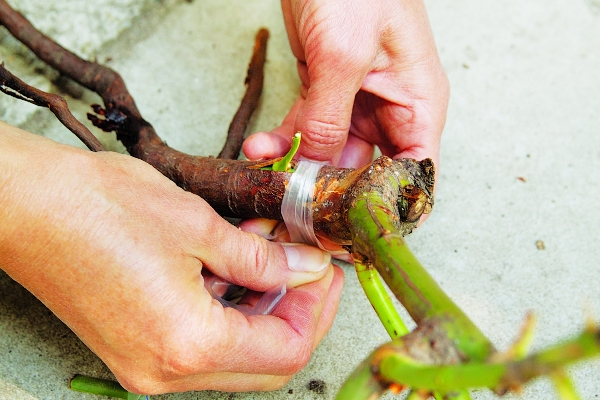Growing roses in the garden, sooner or later you will have to face the technology of grafting on the wild rose. Even a beginner can master this simple procedure.. And this step-by-step instruction will help instill a rose.
Table of contents
Can I plant a rose on a wild rose?
The rose is considered to be a rather moody plant. Requires careful maintenance, mineral-rich soil and a warm climate. You can create a wonderful rose garden by grafting a rose on a wild rose.. There is nothing complicated about it.

In poor climatic conditions, roses slow down their growth, the bushes freeze, the buds do not bloom, and the stems themselves are ill. To avoid this, and spend such agrotechnical technique as budding on the hips.
Fastidious and unique varieties of flowers inoculate less whimsical relatives. With an optimal selection of species of roses, you can ensure their lush flowering in unusual conditions for them. And you can go the other way. Use as a stock wild rose, which is a distant relative of the Queen of Flowers. It is perfectly felt in a harsh climate and does not require special care. A healthy shrub with a well-developed root system is ideal for grafting.
Timing of vaccinations
As for the timing of vaccinations, spring is considered the best period. Leaves and young shoots appear on the bushes. It is important that new stems do not have time to start growing. The plant should not be disturbed during the resting period of the kidneys.
Vaccinated in the summer. In the stems, the active movement of the juice occurs, which contributes to the rapid engraftment of rose cuttings. New shoots have faded and can be used as a graft. The robot starts to spend in July or August.
Use the grafting of roses in the winter - in February. This method is more time consuming and not so popular. The cuttings take root poorly, and the work is quite complicated.
How to plant a rose, step by step instructions
There are several ways to graft this beautiful plant. The first is quite laborious and time stretched. First, wild rose seeds are sown and thin, strong rootstocks are grown. When they get stronger and reach 1 cm in diameter, pick up the graft from the desired varieties of the flower and begin to work.
On the trunk make a T-shaped incision. Insert a kidney with a stump there. Wrap a ribbon for its engraftment. All parts of the dog rose, located above the engrafted kidney, are cut.
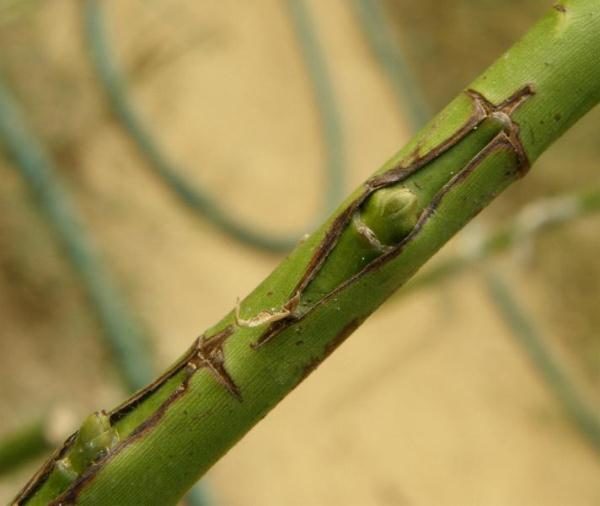
Most gardeners use a different method — quick grafting.. Choose a good graft with two sleeping buds. This rule is mandatory for execution.Shoot thickness should be greater than 6-7 mm. Cut cuttings stored in pieces of wet tissue.
Dogrose selection and preparatory work
As a stock, use the root growth of a briar, age from three years. Choose a shrub with a well-developed root neck, the thickness of which 10 mm. The top layer (bark) must be mature and exfoliate from the wood. Briar dig, carefully remove the ground from the root part and wipe it. The bark should have a light appearance. On the neck of the bush make two oblique incisions with the tongue.
Putting the dog rose, prepare a rose for grafting. Choose the desired area on the stem of the flower and cut the stalk with sleeping buds. Cut length - 5 cm. The movement of the knife should be sharp and to itself. The cuttings are taken slightly thinner than the prepared hips.
Vaccination process
Works begin in mid-March. This is the optimal and generally accepted vaccination period (although there is a summer and winter vaccination).
The prepared cutting is tightly inserted into the incision of the root part of the hips. This is done as follows.: below the kidney stalk make slanting incision 2 cm. Top do cross section with recess on 1–2 mm in the form of a ledge.Then prepare the place of splicing on the hips. A longitudinal section is made in the root part, the bark is removed and the rose stalk is inserted into the hole. The vaccination site is tightly tied with a suitable material - tape, adhesive tape, strips of cloth, polyethylene.
The bushes prepared in this way are placed in a box. If there are many sprouts, they are shifted with improvised materials (sawdust or moss), making sure that they are wet. Add a little crushed coal to prevent mold..
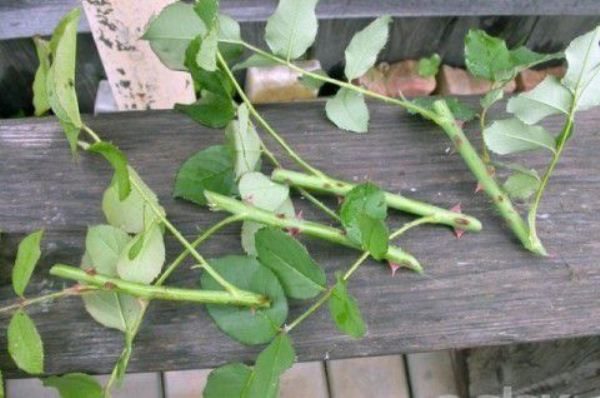
Boxes put in a cool place. The temperature should not exceed 15 degrees heat. Artificially created conditions, such as high humidity, a constant temperature contributes to the appearance of a build-up at the site of vaccination. It is also called “callus” - a callus-like kidney. It is important to observe the required temperature in the room. In case of its reduction to +10 degrees, the formation of "callus" is hampered. A higher temperature leads to active swelling of the kidneys.
After about 20 days boxes are moved to a room with a higher temperature. By this time, the buds will no longer bloom. But the accretion, despite this, will continue. This is a long process, requiring endurance and constant temperature conditions.
Fully cuttings with the root will connect in one and a half to two months. Remove the dressing and planted bushes in the ground, covering the film. Do not allow the drying of the kidneys. To do this, they are wrapped in earth in the form of a small small hillock. With the emergence of new sprouts, the land is gradually raked. This is best done in case of cloudy weather, or in the evening after sunset. So it will be possible to avoid burns of weak emerging shoots.
After the appearance of a sufficient number of leaves proceed to the formation of a rose bush. Trim the tip of the shoot. This stops its development and leads to the appearance of lateral shoots. They are protected, as they will bloom. If the central young escape continues to grow, it is reattached in the area. 5 or 6 sheets. Proper vaccination leads to the formation of 3-5 young symmetrically located shoots.
Grafting in a T-shaped incision, budding
This type of vaccination has its own characteristics. With the help of an abrasive knife on the handle, a peephole is cut with or without wood. Back down from the kidney on top of 8 mm and make a smooth cut down, leaving up to 12 mm under the kidney.
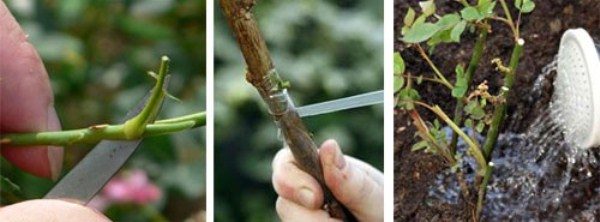
To successfully carry out this operation, you need to do the following:
- under the kidney form a cross section. The movement should be smooth, capturing along with the bark and wood.
- too thick wood is unacceptable. To properly separate the eye, you need experience. Therefore, you should practice your dog rose.
- Perfect cut it turns out smooth, 3-4 cm in length and without visible damage.
When selecting plantings inspect the stems that have faded. From their middle part is the formation of cuttings.
Determine the readiness of the kidneys for grafting on the spikes. If they break off easily without a layer of bark, it means they are ripe.
Care of grafted plants
For the further development of grafted roses, they need the right care. The first week of the bush is abundantly watered.. The area around is cleared of weeds, the soil is loosened in order to avoid the appearance of pests.
After proper inoculation on a bush, young shoots will form in the fall. That he normally wintered, his spud, sprinkled and tamped. In the spring, it's all raked.
In another year, the grafted part of the plant is cut by one peephole. Through 14-20 days wake up the kidneysand the rose will grow. With the advent of three of these leaves pinch the top of the shoot. In the future, the main task is the formation of a lush and spreading bush. And in the fall the plant is planted in a permanent place.
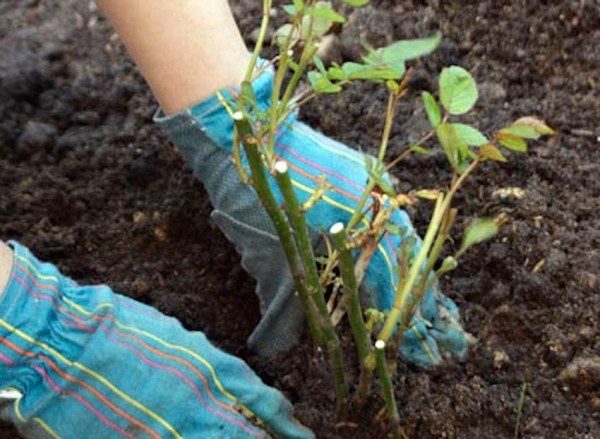
Finally, here are some helpful tips.:
- for stock use plants with well-developed root neck, up to 10 mm thick;
- take mature branchesthat break when bent;
- optimal spike thicknessused for graft - 7 mm
- cut shoots better in the morning to preserve juice;
- prepared grafts stored in wet tissue pieces;
- for comfort better to work in dry weather.
Young grafted roses are planted in the shade. It is necessary to watch how the bush takes roots. If necessary, remove all dead branches and continue to care for roses.
Following these recommendations, you can be sure that your roses will not turn into a rosehip again immediately, but will delight your eyes with its beauty.
